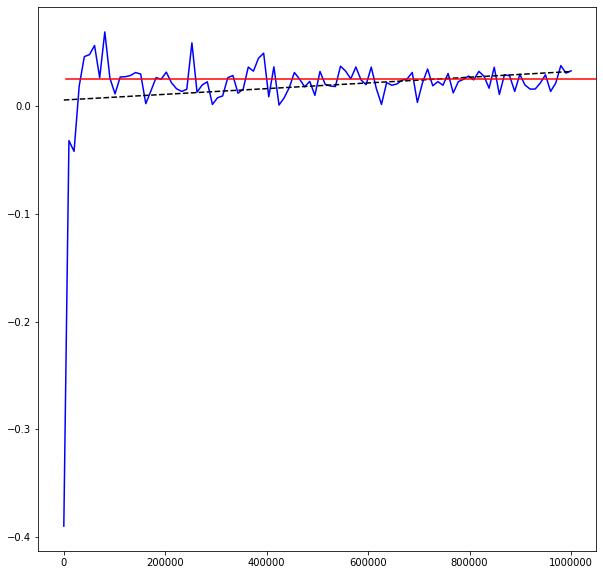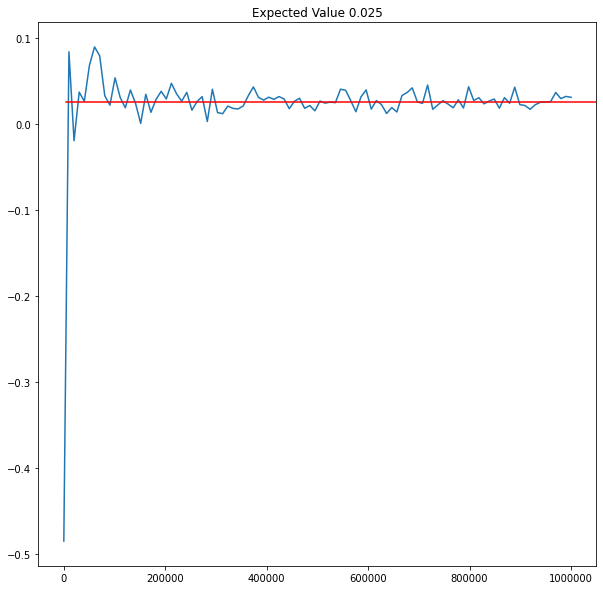の4つめ
Loops and List Comprehensions
の最後の問題。
kaggleのdiscordで質問があったので作ってみた。
通常
MonteCarlo.py
import random
def play_slot_machine():
r = random.random()
if r < .005:
return 100
elif r < .05:
return 5
elif r < .25:
return 1.5
else:
return 0
def estimate_average_slot_payout(n_runs):
"""Run the slot machine n_runs times and return the average net profit per run.
Example calls (note that return value is nondeterministic!):
>>> estimate_average_slot_payout(1)
-1
>>> estimate_average_slot_payout(1)
0.5
"""
r = [play_slot_machine() for _ in range(n_runs)]
return (sum(r) - n_runs) / n_runs
# print(estimate_average_slot_payout(1000000))
# 0.021952
import matplotlib.pyplot as plt
import numpy as np
scale = np.linspace(100,1e6,100)
values = [estimate_average_slot_payout(int(i)) for i in scale]
coef = np.polyfit(scale,values,1)
poly1d_fn = np.poly1d(coef)
fig = plt.figure(figsize=(10,10))
ax = fig.add_subplot(1, 1, 1)
ax.plot(scale,values, '-b', scale, poly1d_fn(scale), '--k')
ax.axhline(y=.025,xmin=.05,c='red')
ax.ticklabel_format(style='plain',axis='x')
期待値である0.025に収縮していくのがわかる。
高速バージョン
faster_plotting.py
import random
# Analytic solution for expected payout =
# .005 * 100 + (.05 - .005) * 5 + (.25 - .05) * 1.5
def play_slot_machine():
r = random.random()
if r < .005:
return 100
elif r < .05:
return 5
elif r < .25:
return 1.5
else:
return 0
import numpy as np
import matplotlib.pyplot as plt
def play_slot_machine(playingcount:int) -> np.ndarray:
return np.random.choice([100,5,1.5,0],playingcount,p=[.005, .045, .2 , 0.75]) - np.ones(playingcount)
def expected_values(num:int) -> float:
return play_slot_machine(num).sum() / num
def ploting(num):
x = np.linspace(100,num,100,dtype=int)
y = [expected_values(i) for i in x]
fig = plt.figure(figsize=(10,10))
ax = fig.add_subplot(1, 1, 1)
ax.plot(x,y)
ax.set_title('Expected Value 0.025')
ax.ticklabel_format(style='plain',axis='x')
ax.axhline(y=.025,xmin=.05,c='red')
return
ploting(1000000)
np.random.choiceで確率に応じて値が抽出できるなと思って作ってみた。(ずっと確率計算でミスをしていて収縮する値が違っていました![]() )
)
yのところはもう少し速くできそう。
みやすく
goodlooking.py
import numpy as np
import matplotlib.pyplot as plt
def play_slot_machine(playingcount:int) -> np.ndarray:
return np.random.choice([100,5,1.5,0],playingcount,p=[.005, .045, .2 , 0.75]) - np.ones(playingcount)
def expected_values(num:int) -> float:
return play_slot_machine(num).sum() / num
def ploting(num):
x = np.linspace(10000,num,100,dtype=int)
y = [expected_values(i) for i in x]
fig = plt.figure(figsize=(10,10))
ax = fig.add_subplot(1, 1, 1)
ax.plot(x,y)
ax.set_title('Expected Value 0.025')
ax.ticklabel_format(style='plain',axis='x')
ax.plot(x,[.025]*100,'r--')
return
ploting(4e7)
最初のばらつきが大きいところをカットしたもの。かなりわかりやすくなった。
期待値のラインもplt.plotに変えている。
せっかく作ったので記念書き込み。


